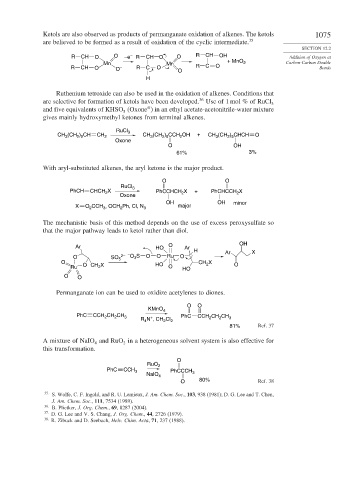Page 1099 - Advanced Organic Chemistry Part B - Reactions & Synthesis
P. 1099
Ketols are also observed as products of permanganate oxidation of alkenes. The ketols 1075
are believed to be formed as a result of oxidation of the cyclic intermediate. 35
SECTION 12.2
R CH O O –e – R C H O O R CH OH Addition of Oxygen at
Mn Mn + MnO 2 Carbon-Carbon Double
R CH O O – R C O O R C O Bonds
H
Ruthenium tetroxide can also be used in the oxidation of alkenes. Conditions that
36
are selective for formation of ketols have been developed. Use of 1 mol % of RuCl 3
®
and five equivalents of KHSO (Oxone ) in an ethyl acetate-acetonitrile-water mixture
5
gives mainly hydroxymethyl ketones from terminal alkenes.
RuCl 3
CH (CH ) CH CH 2 CH (CH ) CCH OH + CH (CH ) CHCH O
2 5
3
3
2
2 5
3
2 5
Oxone
O OH
61% 3%
With aryl-substituted alkenes, the aryl ketone is the major product.
O O
RuCl 3
PhCH CHCH X PhCCHCH 2 X + PhCHCCH 2 X
2
Oxone
OH OH minor
X O 2 CCH , OCH Ph, Cl, N 3 major
2
3
The mechanistic basis of this method depends on the use of excess peroxysulfate so
that the major pathway leads to ketol rather than diol.
Ar HO O Ar OH
H Ar X
O SO 5 2– – O S O O Ru O
3
O HO CH X
2
Ru O CH 2 X O HO O
O O
Permanganate ion can be used to oxidize acetylenes to diones.
O O
KMnO 4
PhC CCH CH CH 3 R N , CH Cl 2 PhC CCH CH CH 3
2
2
2
+
2
2
4
81% Ref. 37
A mixture of NaIO and RuO in a heterogeneous solvent system is also effective for
4
2
this transformation.
O
RuO 2
PhC CCH 3 PhCCCH
NalO 4 3
O 80% Ref. 38
35
S. Wolfe, C. F. Ingold, and R. U. Lemieux, J. Am. Chem. Soc., 103, 938 (1981); D. G. Lee and T. Chen,
J. Am. Chem. Soc., 111, 7534 (1989).
36
B. Plietker, J. Org. Chem., 69, 8287 (2004).
37 D. G. Lee and V. S. Chang, J. Org. Chem., 44, 2726 (1979).
38
R. Zibuck and D. Seebach, Helv. Chim. Acta, 71, 237 (1988).

